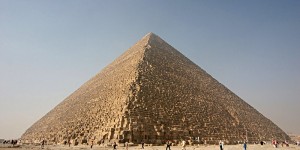Introduction
The medieval capital of Polonnaruva in northern Sri Lanka has a foundation dated to around the 11th to 13th centuries CE and covers an area of around 122 hectares. The site has undergone archaeological survey and investigations from the early colonial period to the recent excavations in the 1980s (Seneviratna 1998, 91; Prematilleke 1982a; 1982b; 1982c; 1985; 1988). This five-year series of systematic excavations led by Prematilleke and funded under UNESCO and The Cultural Triangle, Sri Lanka’s heritage organization, focussed on investigations and conservation of the Buddhist site of the Alahana Parivena within the ancient city of Polonnaruva (Prematilleke 1982a; 1982b; 1982c; 1985; 1988). The archaeological significance of investigating this site provides an insight into Sri Lanka’s past, but can also depict how modern-day interpretations promote socio-political ideologies rooted in idealized historical narratives. With an understanding of Sri Lanka’s current political and ethnic tensions between the Sinhala Buddhists and Tamil Hindus, certain interpretations of the archaeology can be challenged for their biases and personal agendas (Rivzi 2008, 199). These interpretations will be discussed with regard to the circumstances that generate the use of archaeology in nationalist agendas, and how these interpretations can be challenged to provide a more inclusive and holistic narrative of the past.
Historical Context and Early Interventions
To understand the importance of the excavations at Polonnaruva, it must first be discussed how early interpretations of ancient Sri Lankan society were heavily based on the cultural-historical narratives of the early Sinhalese Buddhist texts (Moore 1989; Seneviratna 1991, 373). Texts such as the Culavamsa and Mahavamsa depict the glory of the Sinhalese colonisation of Sri Lanka, depicting it as a region previously uninhabited with only the mention of yakhas, or ‘demonic inhabitants’, as an obstacle that had to be overcome, perhaps a reference to the native inhabitants of the island (Coningham et al. 2017; Coningham and Lewer 1999). The Sinhalese occupation of Polonnaruva began around the 11thto 13th century CE after the abandonment of the old capital of Anuradhapura, and the re-capture of the city from the Colas in 1055 under the Sinhalese King Vijayabahu I, according to historical texts (Seneviratna 1998, 7; Deegalle 1997). As can be seen in modern day interpretations of this historical event, it is often here that the ethnic divide between the Sinhalese and Tamils arise, as displayed in Seneviratna’s quote, from a Cultural Triangle guide book of Polonnaruva, that, “[Vijayabahu I] liberated Sri Lanka from the Colas and brought it under one canopy,” indicating this narrative of a Sinhalese superiority and colonial ideology (Ibid: 7). This imperialist ideology was heavily promoted in the colonial period, when interpretations of Sri Lanka’s past relied on cultural-historical narratives to promote certain biased agendas. H. C. P. Bell, the Archaeological Commissioner from 1890 to the early 1900s, was one of the earliest surveyors and excavators of Polonnaruva in the early 20th century. Bell promoted this narrative as seen in his description that, “the close of the 10th or early 11th c. ushered in that irresistible irruption of Tamils from the Chola country… Until Vijaya Bahu I threw off the foreign yoke,” (Bell 1910, 21) providing a depiction of the ethnic divides created by Western colonial applications of historical texts to the narratives of the past (Devendra 1959; Bell 1908, 6). This colonial framework was utilised not only as a way to dichotomise identities within Sri Lanka, but also to draw a comparative analogy between the superiority of the Sinhalese in colonising the island and the contemporary Western colonisation of Ceylon as a way to legitimise their own rule (Coningham and Lewer 2000).
The presence of the communities of the Tamil Hindus, and how they interacted within the socio-political frameworks of society, is often disregarded in early interpretations of ancient Polonnaruva. Recognition of the presence of Hindu activity has been noted in the early 20th century annual reports on the archaeological surveys of Ceylon, which record nearly a dozen devales (Hindu shrines) present within the ancient walls of Polonnaruva, including the intact structures of Siva Devale Nos. 1, 2, and 3 and Visnu Devale No. 2 (Figure 1) (Bell 1910, 2; Meegama 2010). Early interpretations seem to view these shrines as separate from the Buddhist activity on site, noting that even though they were inside the city walls they appeared to be kept strictly distanced from the other Buddhist shrines (Bell 1910, 10). The term devale classified by Bell is representative of this early emphasis on the study of Buddhist activity on site, as the term is used for the worship of Hindu deities in a Buddhist context rather than the Tamil word kovil, which is used for Hindu shrines housing a deity (Meegama 2010). Although there have been historical publications of the Cola rule in Polonnaruva, there has been very little to nothing at all written about the Hindu temples on site (ibid.). Looking at the social tensions that arise from the continuity of this ethnic ideology through interpretations in time can explain how it affects the agendas surrounding the 1980s UNESCO and Cultural Triangle excavations.
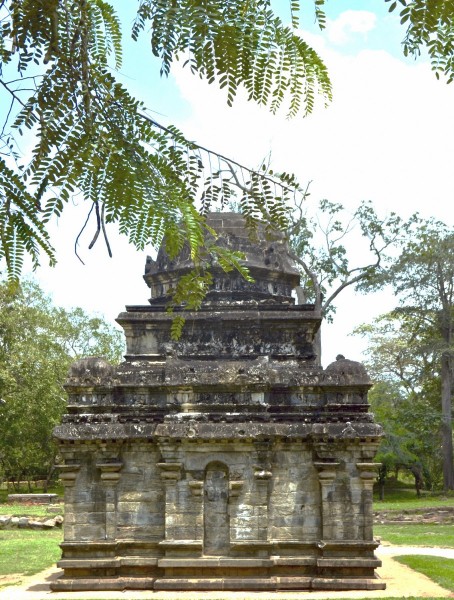
1980s Excavations at Polonnaruva
Background
The sponsored excavations that took place at Polonnaruva in the 1980s were part of a scheme of Sri Lanka’s Cultural Fund to propel the UNESCO-led project termed the ‘Cultural Triangle’ (Prematilleke 1982a, 1). The Cultural Triangle was a project focussed on excavating and conserving major archaeological sites including Anuradhapura, Polonnaruva, Sigiriya, Dambulla, and Kandy with a motivation to understand and preserve the Buddhist heritage at these sites (ibid, 1; Seneviratna 1998, 7). This focus on the Buddhist occupation of the site is made evident with the priorities of the five year long series of excavations taking place at Alahana Parivena, a large Buddhist monastic complex founded in the 12th century CE under Parakramabahu I in the northern part of Ancient Polonnaruva (Prematilleke 1982a, 5-6). The archaeological remains of Polonnaruva include four major areas of the citadel, the outer city, the park area, and the peripheral zone while the Alahana Parivena consists of only a small portion of this larger site (Seneviratna 1998, 94). The overall aims of the excavations were to expose and conserve the medieval phases of the structures within the Alahana Parivena by conducting vertical excavations to better understand the stratigraphy and horizontal archaeology, and consequently understand the relationship of events (ibid., 6). By looking at the data and analysis of the excavation reports it becomes evident how these nationalist and social agendas are implemented in how archaeology is used to narrate the past. As noted in Seneviratna’s guide book of Polonnaruva published under the Cultural Triangle, excavations of the archaeological remains “portrays the ethnic and religious harmony that existed between Sinhalese and Tamils and Buddhists and Hindus respectively,” but whether this interpretation is evident in the archaeology is contested (Seneviratna 1998, 7).
Methodology
The systematic nature of the excavations can be seen in the description of the methodology, covering an area of around 210 acres selected and excavated in 30 metre square grids mainly concentrated in the central and eastern parts of the monastery (Prematilleke 1982a, 6). The excavation reports provide section drawings of all walls of the excavated pits in an appearance of finely detailed documentation, although the presentation of this data is unclear as many of the layers are unlabelled and inclusions, other than brick-built walls, are left out of the drawings (Prematilleke 1982a). Finds were taken into account and recorded in large tables, illustrations, and photographs also included in the excavation reports (Prematilleke 1982a; 1982b; 1982c; 1985; 1988). Conservation of the site after excavation was crucial, as the site was intended to be repurposed as a tourist and pilgrimage destination, and included the cleaning and consolidation of numerous structures of the central monastery terrace as well as the Rankot Vehera, with an emphasis on conserving the dome of the stupa (Prematilleke 1982b, 5). There was also the undertaking of constructing a new modern monastery within the ancient city of Polonnaruva, near the in-use pilgrimage site of the Gal-Vihara, patronised by Sri Lanka’s Minister of Cultural Affairs, evidence of the efforts to conserve Buddhist heritage at Polonnaruva (Prematilleke 1985, 16; 1966; Meegama 2010). Other modern techniques of data collection and recording were used in the last few seasons, including photogrammetry, early computer programming, aerial photography, and contour surveys (Prematilleke 1988, 3-10).
Structural Data
Most of the structures within the Alahana Parivena monastery were for Buddhist worship and use and included structures such as the Kiri Vehera stupa, the Lankatilaka image house, and the Baddhasimapasada chapter house all located on the central terrace with other monastic dwellings and structures around the lower terraces (Prematilleke 1982a, 5). In the fourth season of excavations, a number of buildings were exposed revealing more domestic information about the site including monks’ cells, funerary stupas (corroborating evidence of funerary activities with the earlier burial evidence from the first seasons), a pavilion, and a hospital site (Prematilleke 1982a; 1985, 20). The hospital building itself, identified by artefactual remains and corroborated by the Culavamsa, was patronised by Parakramabahu I as a building for the sick (Prematilleke 1985, 26). These domestic buildings perhaps indicate social spaces where there was more ethnic and religious interaction, although it would be necessary to look at the artefact remains to understand the social and religious activities on site.
Artefactual Data
The series of excavation reports provided in-depth documentation of the artefacts recovered including tables of finds, scaled and free-hand drawings of the objects, and photographs of certain items. A number of ceramic sherds of varying sizes and typologies were found over the seasons and were classified generally either as Local Ceramics or Chinese Wares with in-depth classifications of categories of types and provenances in the later series of reports (Prematilleke 1982a, 14). There was a high concentration of Chinese ceramics, consisting of rims, bases, and body fragments, with a majority of fragments falling within Sung ware (10th to 13th centuries CE) with Grey Celadons being the most common type (ibid., 14). There is a noticeable lack of specialist reports included within the reports themselves. This is most evident in the discussion of the Chinese ceramics involving only a couple of paragraphs mentioning the overall types of finds and provenances without any in-depth analysis, indicating the primary use as a tool for reference chronological dating within a conservationist approach to excavation (Prematilleke 1985, 81).
There is also some evidence of Buddhist bias in interpretation in some of the artefacts recovered in the reports as. A number of sherds recovered with a ‘trident’ symbol were originally identified in the earlier reports as a trisula symbol, a Sanskrit word indicating the trident held by the Hindu deity Shiva, and were noted relabelled as vajra symbols based on the idea that it was a representation of the eight auspicious symbols used in ancient Buddhist monuments (Senadeera 1991/1992; Prematilleke 1982b, 19). There were also a number of terracotta figurines representing human forms recovered and labelled as, “of folk origin,” and, “[characteristic] of primitive art, so distinct in the ancient terracotta sculptures of ancient India,” which were ultimately described as of unknown use in the context of the Buddhist monasteries in the reports (Prematilleke 1985, 43-44). A small figurine of Ganesa was also recovered, but the only analysis provided was that the statuette appeared “to be not too ancient in date,” (ibid., 44). These few instances of Hindu presence are scarcely assessed in the reports and often appear to be interpreted as inexplicable anomalies in a Buddhist context, but it opens up the discussion of social and religious integration in the ancient past.
Discussion
Impact of the Socio-Political Context
As with any planned excavation there are certain factors affecting the aims and objectives, but in the case of the examination of the Polonnaruva reports it is evident that there was an over-emphasis on defining a historical narrative, utilising ancient texts and early colonial accounts, for the aim of conserving a Buddhist heritage and pilgrimage site. Examining the socio-political climate in Sri Lanka from the time of excavations to the modern day helps to explain why this specific focus on a glorified Buddhist heritage has certain ramifications for the existing ethnic and religious tensions within the country.
Sri Lanka is composed of a diverse ethnic and religious population with strong community identities established over centuries from various historical narratives (Coningham and Lewer 2000; Kearney 1998). The Tamil community represents 18 percent of the population of Sri Lanka as one of the largest ethnic minorities on the island and has been the cause of political unrest due to systematic socio-political oppression of a nation-wide dominance of the ideology of a Sinhalese ‘elite’ (Coningham and Lewer 1999). As mentioned earlier, Buddhist historical narratives such as the Culavamsa and Mahavamsa have been manipulated as nationalist propaganda for the glorification of the beginnings of Sri Lankan civilisation under the arrival of the Sinhalese in the 3rd century BC, therefore legitimising the right of this ethnic superiority on the island (Meegama 2010; Coningham and Lewer 2000). Although this has been the political agenda on the island the progression of archaeological discovery throughout the 20th century provided evidence of a Tamil presence on Sri Lanka, pre-dating the arrival of the Sinhalese.
The eruption of confrontation between the two ethnic groups arose in the early 1970s, only a decade before the commencement of excavations funded by the Cultural Triangle at Polonnaruva, and began due to the oppressed Tamil communities beginning to use violent demonstrations in an attempt to voice claims of independence and self-determination (Kearney 1998). The formation of the Liberation Tigers of Tamil Eelam (LTTE) became the source of violent political demonstration. This included attacks in the 1980s such as on the sacred Bodhi Tree in Anuradhapura and the murder of Buddhist monks in Trincomalee, and the bombing of the Temple of the Tooth in Kandy in the 1990s (Coningham and Lewer 1999; Wijesuriya 2000). These violent social and political tensions existed at the time of excavation and are sure to have been a major factor influencing interpretation of the archaeology and workings of society of ancient Polonnaruva.
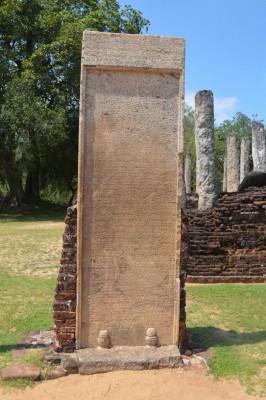
Development of a Holistic Interpretation
After conducting a reassessment of the archaeology taking into account the socio-political biases affecting interpretation it is possible to present a more integrated society of the past. In more recent years there has been a shift in interpretation attempting to present a harmonious relationship between the Sinhalese and Tamils of the past. Artefacts such the Tamil inscriptions from the Temple of the Tooth in Polonnaruva have been retranslated by Mudaliyár in 1924, and presents the integration of the Tamil community by mentioning, “May the Velaikkaras always look after, for the good of the world, the Tooth Relic temple… at the command of Sri Vijaya Bahu,” (Figure 2) (Mudaliyár 1924, 274). Although this inscription does provide primary evidence for a cultural distinction between the Sinhalese and Tamil groups, at least in the context of a public inscription, it depicts interaction between groups and acknowledges the unsurprising presence of Tamils at Polonnaruva prior to the ascension of Vijayabahu I’s control (Mudaliyár 1924). Other evidences of the integration of communities can be extracted from other artefact remains, especially from the Prematilleke reports. As mentioned in the artefact findings, the presence of ceramic sherds with the trisula symbol appear to be indicators of Hindu activity within the Alahana Parivena, but which was ultimately dismissed and re-labelled as the vajra, a Buddhist symbol (Prematilleke 1982b, 10). The first season of excavation found sherds with this symbol in a pit assemblage consisting of beads, charcoal, copper pieces, and iron nails which all indicated occupational phases earlier than the 12th to13th centuries CE. It also corroborated the chronology of the construction of the Alahana Parivena, although the excavation reports do not go into further discussion of these results (Prematilleke 1982a, 9). Other traditional Hindu designs have been identified on sherds from the excavations and have also been identified from modern surveys in the country’s hinterland. Furthermore, bronze figurines have been identified as depicting deities of Siva and Parvati, providing evidence for this large, unaccounted-for Hindu community in the archaeology with some level of interaction with the Buddhist communities (Bell 1908; Coningham et al. 2017; Nishanthi 2016). More investigations into the outskirts of the ancient city walls would also provide more evidence for social and religious interactions, as already seen conducted at Anuradhapura (Coningham et al. 2007).
A large portion of interpretation also focussed on the structural remains and the increased interest in the Hindu structures. As mentioned earlier, Seneviratna’s guide book published around a decade after the excavations at Polonnaruva mentions this ‘ethnic harmony’ in the presence of integrated Tamil and Sinhalese communities and states that “the archaeological remains corroborate this fact” (Seneviratna 1998, 7). From the colonial-period descriptions of the Hindu devales, this guide book is one of the few modern publications which interprets Siva Devale No. 1 in the context of a Buddhist heritage site as an indication of ‘complete harmony’ (Seneviratna 1998, 124). The influences of the modern socio-political climate have promulgated the necessity of inclusive archaeological interventions, and the UNESCO Central Cultural Fund has made plans to conduct investigations at Siva Devale No. 2 (Coningham et al. 2017). There is also a visible shift from the traditional approach of categorising architectural elements into ‘Sinhalese-Buddhist’ or Tamil-Hindu’ traditions as a replacement of old cultural-historical and colonial approaches for post-colonial and post-processual interpretations of constructional methodologies (Bell 1910, 17; Meegama 2010; Rivzi 2008, 197). Tambiah sums up this changing focus by noting that archaeological remains should be treated as a representation of a nation’s cultural heritage, rather than labelled as ‘Sinhalese’ or ‘Buddhist’ (Tambiah 1992; Coningham et al. 2017).
Another important factor for the development of holistic interpretations is the increasing diversity within historical and archaeological authorship, from a past of mostly Western colonial and Sinhalese-dominated publications of historical material (Godakumbura 1969; Jazeel and MacFarlane 2010). The rise of Tamil and Hindu authors publishing interpretations provides a diversity of interpretations in the literature. The Tamil historian Indrapala has provided interpretations of a great early Tamil presence during the Cola reign and has attributed the construction of the devales to the 10th century, prior to Sinhalese intervention (Indrapala 1969; Coningham et al. 2017). Pathamanathan, another Tamil author, has also drawn attention to the presence of Buddhist temple constructions during Cola reigns and the fact that the overall shift of the Sinhalese capital to Polonnaruva was an indication of greater integration between religious communities, incorporating Hindu and Buddhist practices (Coningham et al. 2017). He also analysed the presence of a Tamil Pillar within the Rankot Vihara of the Alahana Parivena as a sign of integrated Tamil activity at the Buddhist monastery (Pathamanathan 2004).
Conclusion
The assessment of the interpretations of Polonnaruva is a perfect example of how South Asian archaeological interpretations have changed and developed over time and within their national context. The circumstantial regional socio-political factors and periods in which an excavation is conducted should be taken into account when understanding archaeological interpretations, and the site of Polonnaruva is no exception. As summed up in this essay, the development of a holistic interpretation of Sri Lankan archaeological sites can provide a variety of alternative narratives that are conscious of modern contextual biases and how these may change with diverse and modernised perspectives.


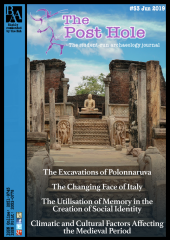

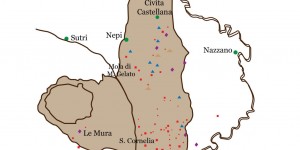
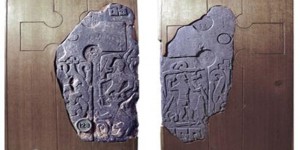
![A carved reindeer bone from a midden at Sumtangen (author’s own illustration). The runic inscription reads ‘ottar a’ (Óttár owns [this]). These name tags with a personal name and the verb ‘a’ are commonly found in middens in Norwegian towns (Indrelid and Hufthammer 2011, 45).](https://theposthole.org/sites/theposthole.org/files/styles/article_thumb/public/articles/_temp_thumbs/Owen%20Image%201.png?itok=sFxpxvar)
